
Sea urchins or urchins are typically spiny, globular animals, echinoderms in the class Echinoidea. About 950 species live on the seabed, inhabiting all oceans and depth zones from the intertidal to 5,000 metres. Their tests are round and spiny, typically from 3 to 10 cm across. Sea urchins move slowly, crawling with their tube feet, and sometimes pushing themselves with their spines. They feed primarily on algae but also eat slow-moving or sessile animals. Their predators include sea otters, starfish, wolf eels, and triggerfish.

The red sea urchin is a sea urchin found in the northeastern Pacific Ocean from Alaska to Baja California. It lives in shallow waters from the low-tide line to greater than 280 m (920 ft) deep, and is typically found on rocky shores sheltered from extreme wave action in areas where kelp is available.

Diadema is a genus of sea urchins of the family Diadematidae.

Kina is a sea urchin endemic to New Zealand. This echinoderm belongs to the family Echinometridae and it can reach a maximum diameter of 16–17 cm.

Echinus esculentus, the European edible sea urchin or common sea urchin, is a species of marine invertebrate in the Echinidae family. It is found in coastal areas of western Europe down to a depth of 1,200 m (3,900 ft). It is considered "Near threatened" in the IUCN Red List of Threatened Species.

Lytechinus variegatus, commonly called the green sea urchin or the variegated sea urchin, is a species of sea urchin that can be found in the warm waters of the western Atlantic Ocean and Caribbean Sea.

Strongylocentrotus droebachiensis is commonly known as the green sea urchin because of its characteristic green color, not to be confused with Psammechinus miliaris as it is also commonly called the green sea urchin. It is commonly found in northern waters all around the world including both the Pacific and Atlantic Oceans to a northerly latitude of 81 degrees and as far south as Maine and England. The average adult size is around 50 mm (2 in), but it has been recorded at a diameter of 87 mm (3.4 in). The green sea urchin prefers to eat seaweeds but will eat other organisms. They are eaten by a variety of predators, including sea stars, crabs, large fish, mammals, birds, and humans. The species name "droebachiensis" is derived from the name of the town Drøbak in Norway.

Echinus is a genus of sea urchins. Sea urchins are echinoderms that are typically spherical or flattened with a covering of spine-like structures. Sea urchins tend to be important members of their ecosystems by grazing on other organisms and stabilizing populations. In addition to this, sea urchins play a large role in different economies globally as the urchin themselves and their roe are sold for consumption. The same is true for the species within the genus Echinus.
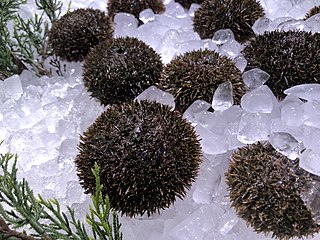
Hemicentrotus pulcherrimus is a species of sea urchin, the only one in the monotypic genus Hemicentrotus. It was first described by the American engineer and marine zoologist Alexander Agassiz in 1864 as Psammechinus pulcherrimus. Its range extends along the coasts of Korea, Taiwan and China, and in Japan from Kyūshū to Ishikari Bay. An edible species, it is harvested from Kyūshū to Fukui, in the Sea of Japan.
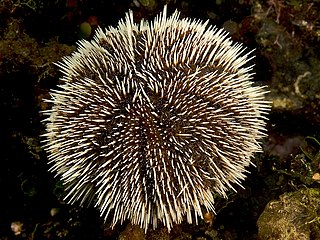
Tripneustes ventricosus, commonly called the West Indian sea egg or white sea urchin, is a species of sea urchin. It is common in the Caribbean Sea, the Bahamas and Florida and may be found at depths of less than 10 metres (33 ft).

Echinometra mathaei, the burrowing urchin, is a species of sea urchin in the family Echinometridae. It occurs in shallow waters in the Indo-Pacific region. The type locality is Mauritius.
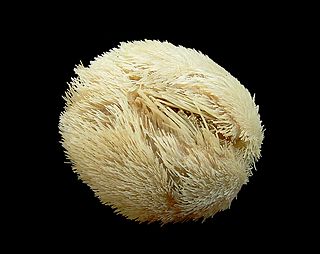
Echinocardium cordatum, also known as the common heart urchin or the sea potato, is a sea urchin in the family Loveniidae. It is found in sub-tidal regions in temperate seas throughout the world. It lives buried in the sandy sea floor.
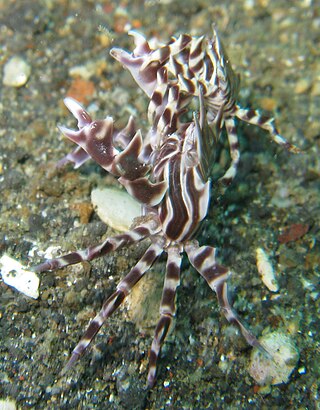
Zebrida adamsii is a distinctively striped species of crab that lives in association with a sea urchin in the Indo-Pacific region. It is cryptically coloured with vertical stripes and has special adaptations to its legs to enable it to cling to its host's spines.
Aspidodiadema jacobyi is a small sea urchin in the family Aspidodiadematidae. It lives in tropical seas at great depths. Aspidodiadema jacobyi was first scientifically described in 1880 by Alexander Emanuel Agassiz, an American scientist.
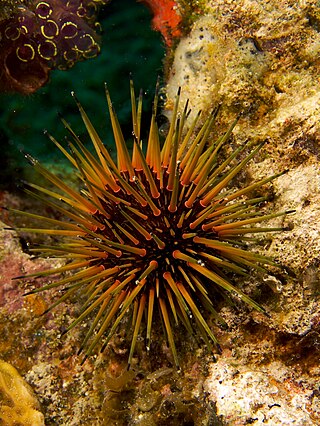
Echinometra viridis, the reef urchin, is a species of sea urchin in the family Echinometridae. It is found on reefs in very shallow parts of the western Atlantic Ocean and the Caribbean Sea.
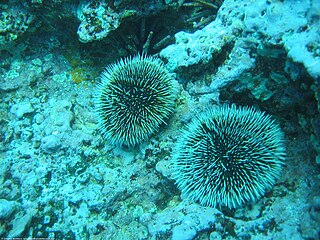
Tripneustes depressus, the white sea urchin or sea egg, is a species of sea urchin in the family Toxopneustidae. It is found on the seabed in the tropical eastern Pacific Ocean including Mexico, Panama, Ecuador and the Galápagos Islands.

Cidaris blakei is a species of sea urchins of the family Cidaridae. Its armour is covered with spines of three types, one unique type being extended and fan-like, making it easily recognized. Alexander Agassiz first described it scientifically in 1878. It is present on the seabed in deep waters in the Gulf of Mexico and the Bahamas.

Toxopneustes roseus is a species of sea urchin from the East Pacific. It is sometimes known as the rose flower urchin or the pink flower urchin. Like the related flower urchin, they are venomous.

Tetrapygus is a genus of sea urchins in the family Arbaciidae. It is a monotypic genus and the only species is Tetrapygus niger which was first described by the Chilean naturalist Juan Ignacio Molina in 1782. It is found in the southeastern Pacific Ocean on the coasts of South America.
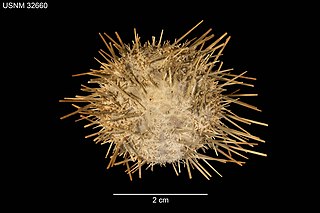
Lytechinus pictus, commonly known as the painted urchin, is a sea urchin in the family Toxopneustidae. It occurs on shallow reefs in the tropical and subtropical eastern Pacific Ocean, off the coasts of California, Central America and South America as far south as Ecuador.


















